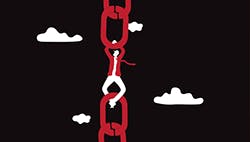Logically, one of the best ways to reduce the impact of long lead times is to keep suppliers of raw materials and parts to a minimum and keep them geographically close as possible—and reduce links in the supply chain and potential delays.
“The U.S. is trying to onshore its semiconductor manufacturing with the Chips Act of 2022 to help chipmakers and reduce its dependence on China and Malaysia,” says Vikram Kumar, CEO of the Uticor division of AVG Group. “We also make our products in the U.S., and produce our own circuit boards and some semiconductors. This is helpful in keeping up with our customer demand, but everyone still has supply chain issues. However, due to our vertical integration and utilization of our own part sourcing within our U.S. companies, we’re still able to ship products in seven to 10 days, while many competitors are taking 26-52 weeks. We’re also seeing transportation costs simultaneously skyrocketing due to the war in Ukraine and gas prices. Fortunately for Uticor, we have to deal with fewer moving parts and fewer suppliers, who in turn have their own supply chain issues and long lead times.”
Kumar reports that one of Uticor’s customers is building a new plant, and standardized on Rockwell PLCs and HMIs per its corporate specs, until it learned that its lead times were 40 weeks. It was also using AVG Autotech’s encoders, and learned it could deploy HMIs from Uticor, which is eventually allowing its new facility to open on time. “Beyond considering alternative products, distributors are also advising clients to stock up and/or establish consignments or blanket orders for products they’ll definitely use,” says Kumar. “At the same time, manufacturers are requiring distributors to inform them what projects their orders are assigned to in order to avoid potential hoarding and subsequent price gouging.”
Connect and automate sourcing
This article is part of a series about the automation supply chain. Read more on the topic here.
Because stocking up can sometimes lead to overordering, and shutdowns can throw far more equipment into disuse, Kumar adds he’s been working with Sujee Jeganathan, founder and CEO of TrustClarity, which is a three-year-old, circular-economy-focused, e-commerce platform for buying and selling excess, new and refurbished parts and equipment.
“Long lead times and uncertainty by manufacturers on future deliverability of components and finished goods are common today. Many companies don’t have a good enough demand forecast to handle this uncertainty, so they overorder to mitigate the risk of not being able to service their customers,” says Jeganathan. “The downstream impact is that many companies end up with unusually high surplus parts, components and finished goods, while others are stranded without any inventory.
“Other plants reopening and updating machinery after COVID-19 may need these older, fully functional, new, excess components to restart. That’s the beauty behind TrustClarity because it connects and automates sourcing teams from different companies, so the company starved of inventory has a solution rather than waiting the 26-52-week lead times straight from the manufacturer, while the company with excess items isn’t throwing away usable parts. It’s a win-win for everyone.”
Jeganathan reports that most companies don’t have the infrastructure, processes or people in place to easily resell their excess surplus parts or finished goods, unfortunately resulting in scrapping functional, often new and reusable products that fill up landfills. However, he adds that many companies have also been trying to act more sustainably, and are finding solutions to simplify the process of redeploying assets they previously would have thrown out.
“TrustClarity’s software-as-a-service (SasS) platform uses artificial intelligence (AI) and blockchain technology to help end users easily identify, list, sell and redeploy new and used surplus equipment,” says Jeganathan. “With a few clicks, we help companies go from an Excel spreadsheet with excess inventory to selling online with cash received, and a buyer picking up a skid load of goods at their door. We remove the friction that many companies experience when trying to resell and handle the logistics of these products.”







